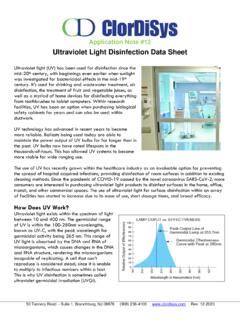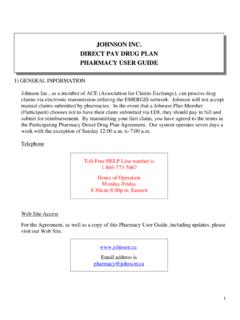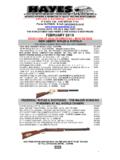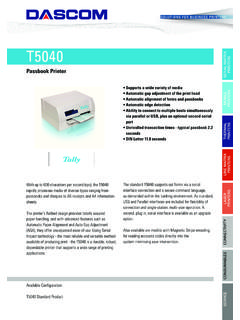Transcription of Environmental Monitoring and Decontamination …
1 1 PHARMACEUTICAL ENGINEERING November/December 2012manufacturing and operationsEnvironmental Monitoring /DecontaminationIntroductionEn vironmental Monitoring and Testing of Pharmaceutical FacilitiesM aintaining a comprehensive Environmental Monitoring pro-gram is critical to the pharma-ceutical industry, as it can act as an early indication for potential contamination of products. An effective Environmental moni-toring program includes the sampling of microbiological risk areas within the plant to find organisms before they get into the product, and verifying that all cleaning and sani-tizing procedures are working effectively. When analyzing and revising a sampling program, many questions must be answered.
2 What organisms (bacteria, viruses, fungi, spores) are of greatest concern? What are the acceptable microbio-logical limits for our sample results? Where should we take samples from? Is air sampling necessary? The first step is to understand the microorganism(s) of concern. What is the primary habitat? Some, like Staphylococcus and Pseudomonas, are found on people s skin, hair, nasal passageways, and mouth; or is it a soil organism (like Bacillus spp)? Sources can be very widespread for many microorganisms and can include the great outdoors, ingredients, the production plant environment, pallets, drains, humans, animals, and insects. What nutrients and conditions (water availability, oxy-gen, temperature, pH, etc.)
3 Are required for the organism to grow and survive? Organisms like Pseudomonas spp and yeasts thrive in moist environments. What are the necessary steps required to kill the organ-ism (sterilization, disinfecting solutions, fumigation)? Has the organism been implicated in contamination for the same or similar products? Pseudomonas spp has been linked with contaminations in Liquids, Ointments, and Creams (LOCs). Are there USP tests available to detect the organisms? Some organisms (like B. cepacia) are not detected by cur-rent USP tests. What should you be concerned with? Some bacteria have a high infectious dose in order for most individuals to ex-hibit symptoms (Bacillus spp is ~105 108 viable cells or spores).
4 Others such as Staphylococcus spp and Pseudo-monas spp can come from people (workers) and are easy to kill, but have the ability to quickly become the beginning of an Environmental Monitoring program review, in-depth baseline testing should be done to thor-oughly understand the plant environment and location of harbors and niches where organisms reside. There are two components of an Environmental Monitoring program and both can be failure points: the sampling frequency and the Environmental Monitoring and Decontamination of Pharmaceutical Production FacilitiesPaul Lorcheim and Melissa Hughes This article reviews a facilities Environmental Monitoring program and the Decontamination measures that might need to be added in order to achieve satisfactory results within the fromPHARMACEUTICAL ENGINEERINGThe Official Technical Magazine Of iSPeNovEMbER/DEcEMbER 2012, vol 32, No 6 copyright ISPE 2012 PHARMACEUTICAL ENGINEERING manufacturing and operationsEnvironmental Monitoring /Decontaminationsampling method.
5 Sampling methods should include air sampling, both passive and active, to measure the quantity and type of airborne organisms present. Swabbing both wide areas as well as pinpoint areas in crevices and on equipment also should be performed. During the initial Environmental Monitoring phase, as well as periodically thereafter, both Total Aerobic Plate Counts (TPC) as well as identifying specifically what organisms are present should be performed. This provides a good baseline of what organisms are present. Sample locations should be expanded to test the hard-to-reach areas that might not be easily accessible and might require the disassembly of some equipment and components in order to properly sample and survey them.
6 Much like the rule of Real Estate, the rule of sampling is location, location, location. It s important to test in as many locations as pos-sible, including ones that have never been tested before. The goal is to have as complete a survey of the facility as possible, knowing where contaminations originate and are harbored. Once this baseline has been established, the normal cleaning and sanitizing methods should be performed. It is important that the cleaning step be performed without forewarning of the review such that the truest measure of the cleaning staff and the cleaning program are taken. Indicator organisms and biological indicators are commonly used during this step, and placed throughout the facility, allowing for a measurable result of the cleaning that was performed.
7 Upon completion of the standard cleaning method, another round of sampling should occur and the indicators can be tested to gauge the efficacy of the established cleaning presence of these organisms in the pharmaceutical facilities can lead to costly product recalls, which can result in loss of revenue, customers, prestige, and brand reputation. Contamination continues to be a difficult challenge for all sectors of the pharmaceutical industry and poses a significant hazard to human health. The presence of these organisms in the pharmaceutical facilities can lead to costly product recalls, which can result in loss of revenue, custom-ers, prestige, and brand reputation. Bad publicity, expensive legal fees, increased insurance premiums, and perhaps even closure are other potential hazards of plant contamination.
8 Another important step in setting up an Environmental sampling plan is to know your product, the target con-sumer group (children, the elderly, pregnant women, and immunocompromised individuals are more susceptible to bacteria induced illness), and the environment in which the drug is being produced. Certain products and manufactur-ing operations are more susceptible to certain microbial contaminants, making the sampling of those organisms a priority. Some processing facility attributes to consider are the following: Type of processing (terminal sterilization available or not) Plant cleaning and sanitation schedule Rotation of sanitizers Separation of production and storage areas Flow of product compared to worker traffic patterns Age and wear of equipment and facilities Presence of rust Floors, drains, roof, and overhead concerns Standing water Air handling systems and dust Pest control and trash management Sink areas So what corrective and preventive action needs to occur if the sample results show that the standard cleaning method is not able to satisfy the requirements of the Environmental Monitoring program and positive samples are being found?
9 The facility must look at the source of contamination for a possible solution (replacing equipment with more sanitary model?) or enact a more thorough cleaning step through a more aggressive cleaning agent. The frequency that the en-vironmental Monitoring program should perform sampling should be determined by the facility s management. One factor to consider when determining a sampling schedule includes the maximum production batch acceptable to recall if positive samples are found. Sanitization frequency would be determined through a similar process based on sampling results and the sanitization method s potency. If a facility s Environmental Monitoring results stay good for three weeks, but then positives arise after four weeks, it might be neces-sary to increase the Decontamination frequency using the existing method or to move to a more effective method to eliminate a greater portion of the organisms initially.
10 High-Level Antimicrobial Cleaning MethodsThe United States Environmental Protection Agency (US EPA) defines antimicrobial pesticides as substances or mix-tures of substances used to destroy or suppress the growth of harmful microorganisms, such as bacteria, viruses, or fungi on a variety of objects and surfaces. Antimicrobial pesticides have two major uses:3 PHARMACEUTICAL ENGINEERING November/December 2012manufacturing and operationsEnvironmental Monitoring / Decontamination To disinfect, sanitize, reduce, or mitigate growth or devel-opment of microbiological organisms To protect objects ( , floors and walls), industrial processes or systems, surfaces, water, or other chemical substances from contamination, fouling, or deteriora-tion caused by bacteria, viruses, fungi, protozoa, algae, or slime1 Pesticides are classified by their levels of kill by the USEPA,1 which are: Antiseptics and Germicides: used to prevent infec-tion and decay by inhibiting the growth of microorgan-isms.






